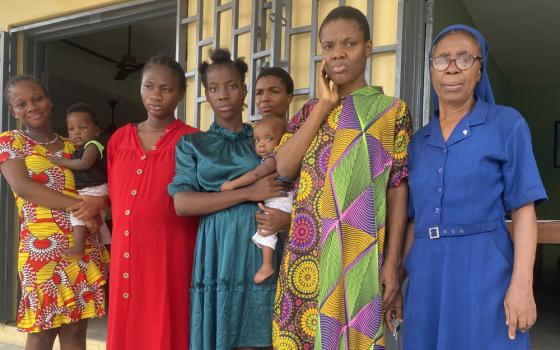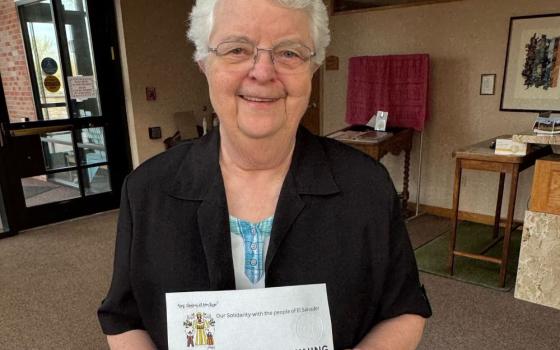
A U.S. defense department document released in January and reports last month of the anticipated release of a presidential study on nuclear arms have raised expectations about a potentially significant reduction in the number of the country’s deployed nuclear weapons.
At the same time, President Barack Obama’s proposed federal budget for fiscal year 2013 calls for delaying construction of a planned nuclear weapons manufacturing facility at the national laboratory in Los Alamos, N.M., for five years.
While analysts told NCR they were taking a wait-and-see attitude on the larger implications of the possible weapons cuts and the facility’s postponement, they also expressed some hope the two might bode well for a smaller nuclear weapons complex.
The president’s expected Nuclear Posture Review implementation study follows release of a “guidance” document from the Defense Department in early January that stated “it is possible that our deterrence goals can be achieved with a smaller nuclear force.”
The guidance gave no specific numbers, but reports in mid-February said that Obama may be considering a deployed nuclear force of between 300 to 1,100 warheads. While the current number of deployed warheads is confidential, according to treaty limits the U.S. can only deploy up to 1,550. The U.S. bishops seem to be trying to turn some of the cautious hope about the moves into action. In a March 2 letter, the Department of Justice, Peace and Human Development of the U.S. Conference of Catholic Bishops asked people to sign an online petition calling on Obama to take “dramatic steps” toward nuclear disarmament in his implementation study.
Referencing the president’s promise to “move towards disarmament” in an April 2009 speech in Prague, Czech Republic, the petition calls on Obama to “make good on his commitment” by pursuing “dramatic steps that would make us all safer from the threat of nuclear weapons.”
In 2010, Obama released his Nuclear Posture Review, an assessment of the roles and missions for U.S. nuclear forces put forward by every president since the end of the Cold War. The implementation study is expected to give specific numbers of warheads to be maintained.
While the U.S. is said to have a total stockpile of some 8,000 nuclear warheads, past presidents’ studies only addressed those that are deployed strategically, not those that are kept in active reserve or inactive storage.
The president’s fiscal year 2013 budget, released Feb. 13, calls for cutting some $487 billion from the Defense Department.
Funding for the nation’s nuclear program comes from the Department of Energy. The cost of the Los Alamos National Laboratory has ballooned from $660 million in 2004 to a high estimate of $5.9 billion today.
It was also reported last month that the director of the Los Alamos facility planned to reduce the lab’s workforce by up to 800 employees before the end of spring through a voluntary separation program. In a press statement about the workforce cuts, Charles McMillan said that the lab’s federal budget allocation was more than $300 million lower in 2012 than in 2011.
One analyst with a long history of studying the Los Alamos facility told NCR he is skeptical that postponement of the new site is a positive sign that the country is more seriously considering nuclear disarmament.
“The fact that they’re deferring the ... facility for five years, I would not describe that as a step toward disarmament,” said Jay Coghlan, executive director of Nuclear Watch New Mexico. “They’re doing it because of fiscal realities.”
Another analyst, however, said the decision could have wider implications for U.S. commitment to nuclear disarmament.
“The hope of analysts is that the [study] takes another step in reducing reliance on nuclear weapons,” said Nickolas Roth, a policy fellow at the Center for Arms Control and Non-Proliferation.
Citing reports that the study could involve cuts in the number of strategic warheads deployed or even taking weapons off “hair-trigger alert” by slowing down the time frame in which the U.S. could launch a nuclear strike, Roth said he’s “still hopeful that there will be a modest policy change.”
The postponement will halt the nation’s expanding capacity to produce plutonium pits, a key component of nuclear weapons, Roth wrote in a report on his center’s website.
Plutonium pit production, which the military says is needed to replace pits in older nuclear warheads, is limited by law to 20 pits per year. According to Roth’s report, the new Los Alamos facility already “plans to increase that capacity to 50 pits by 2015.”
The new facility at Los Alamos, Roth wrote, “would restore capacity originally intended to support a Cold War-sized nuclear arsenal."
While Coghlan said he remains skeptical about the postponement, he did say the move shows there is a “lack of clear need” for the increased capability to produce pits.
He also noted that the president’s budget continues to fund planned new nuclear weapons manufacturing facilities in Oak Ridge, Tenn., and Kansas City, Mo. The Oak Ridge plant, known as the Uranium Processing Facility, carries a price tag estimated to be as high as $6.5 billion.
While Roth said that he “wouldn’t consider any of the steps that we’re talking about right now as steps toward disarmament,” he did say he had hopes they might gradually reduce the country’s reliance on nuclear weapons.
“We’re a long way between what we have and what’s going to be proposed even under the best of circumstances,” he said. “But I think the idea is to gradually reduce the United States’ reliance on nuclear weapons.”
Roth said that delay might give the federal government a chance to “reevaluate whether they think they need the ramp-up capability” in nuclear weapons production that might come from construction of new manufacturing sites.
“There’s a lot of evidence that shows they don’t need it right now,” he said.
[Joshua J. McElwee is an NCR staff writer. His email address is jmcelwee@ncronline.org.]



